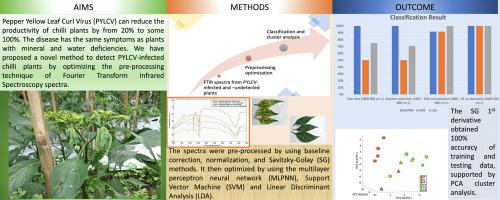Spectrochimica Acta Part A: Molecular and Biomolecular Spectroscopy ( IF 4.3 ) Pub Date : 2022-05-04 , DOI: 10.1016/j.saa.2022.121339 Dyah K Agustika 1 , Ixora Mercuriani 2 , Chandra W Purnomo 3 , Sedyo Hartono 4 , Kuwat Triyana 5 , Doina D Iliescu 6 , Mark S Leeson 6

|
Pre-processing is a crucial step in analyzing spectra from Fourier transform infrared (FTIR) spectroscopy because it can reduce unwanted noise and enhance system performance. Here, we present the results of pre-processing technique optimization to facilitate the detection of pepper yellow leaf curl virus (PYLCV)-infected chilli plants using FTIR spectroscopy. Optimization of a range of pre-processing techniques was undertaken, namely baseline correction, normalization (standard normal variate, vector, and min–max), and de-noising (Savitzky-Golay (SG) smoothing, 1st and 2 derivatives). The pre-processing was applied to the mid-infrared spectral range (4000 – 400 cm−1) and the biofingerprint region (1800 – 900 cm−1) then the discrete wavelet transform (DWT) was used for dimension reduction. The pre-processed data were then used as an input for classification using a multilayer perceptron neural network, a support vector machine, and linear discriminant analysis. The pre-processing method with the highest classification model accuracy was selected for the further use in the processing. It was seen that only the SG 1st derivative method applied to both wavenumber ranges could produce 100% accuracy. This result was supported by principal component analysis clustering. Thus, we have demonstrated that by using the right pre-processing technique, classification success can be increased, and the process simplified by optimization and minimization of the technique used.
中文翻译:

检测PYLCV感染辣椒植株的傅里叶变换红外光谱预处理技术选择
预处理是分析傅里叶变换红外 (FTIR) 光谱的关键步骤,因为它可以减少不需要的噪声并提高系统性能。在这里,我们展示了预处理技术优化的结果,以促进使用 FTIR 光谱检测辣椒黄叶卷曲病毒 (PYLCV) 感染的辣椒植物。对一系列预处理技术进行了优化,即基线校正、归一化(标准正态变量、向量和最小-最大值)和去噪(Savitzky-Golay (SG) 平滑、一阶和二阶导数)。预处理应用于中红外光谱范围(4000 – 400 cm -1)和生物指纹区域(1800 – 900 cm -1) 然后使用离散小波变换 (DWT) 进行降维。然后使用多层感知器神经网络、支持向量机和线性判别分析将预处理数据用作分类的输入。选择分类模型精度最高的预处理方法进行进一步处理。可以看出,只有应用于两个波数范围的 SG 一阶导数方法才能产生 100% 的准确度。这一结果得到了主成分分析聚类的支持。因此,我们已经证明,通过使用正确的预处理技术,可以提高分类成功率,并通过优化和最小化所使用的技术来简化过程。











































 京公网安备 11010802027423号
京公网安备 11010802027423号